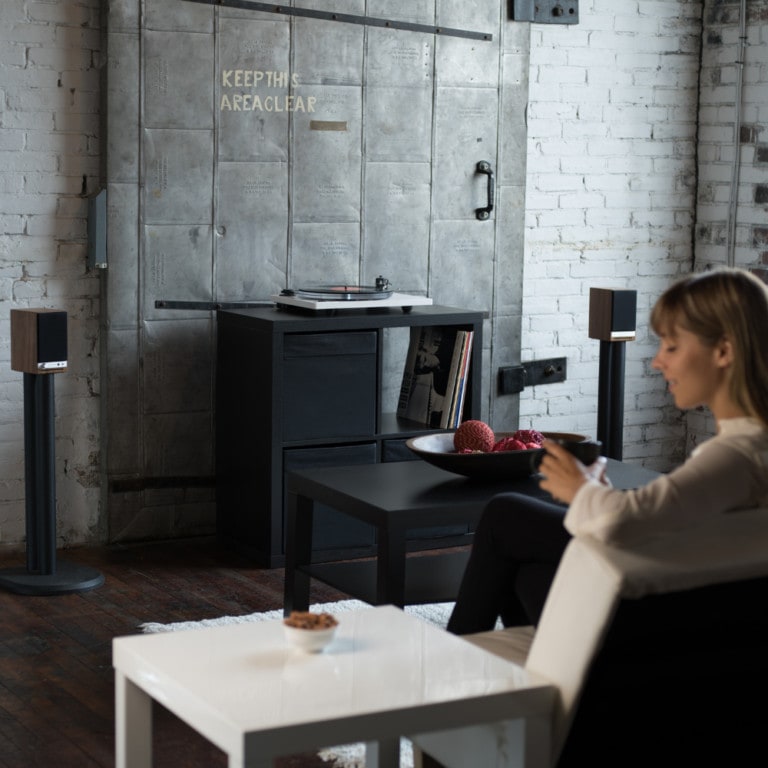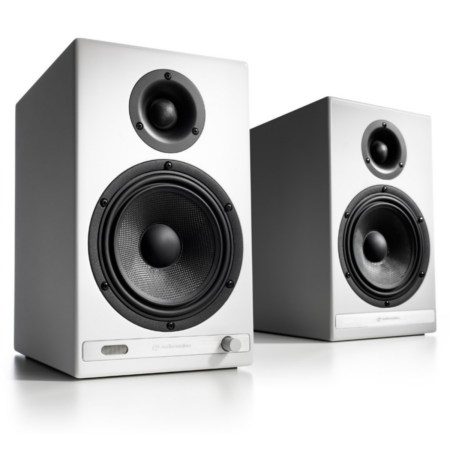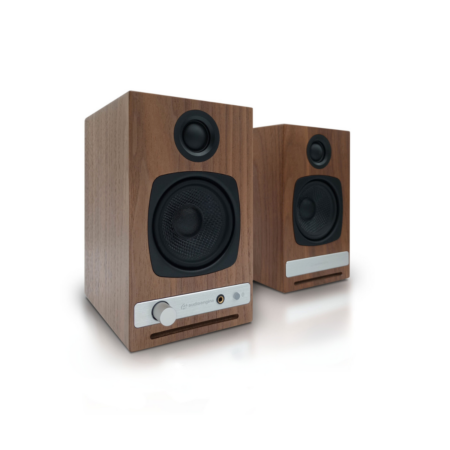
A5+ Home Music System w/ Bluetooth aptX-HD (Open Box)
Pro Tip To get the best sound from your A5+ Wireless, connect via Bluetooth. This connection bypasses the lower quality DAC in your streaming device, utilizing the speaker's built-in DAC for improved audio clarity and fidelity.
$399 – $455
Enter your postal code to estimate delivery time from Texas:
Frequently bought together
Frequently bought together





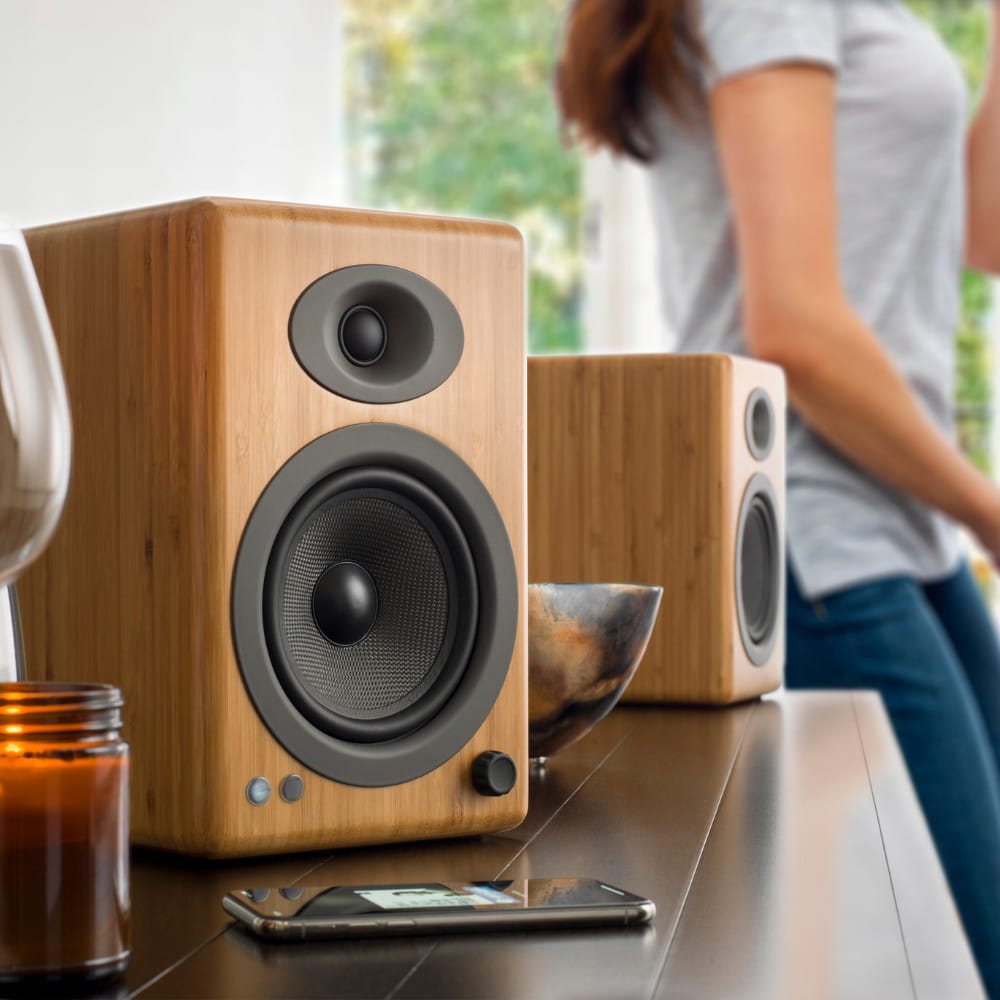
Just Wait Until You Hear Them
The A5+ Wireless Speakers are built with custom Audioengine components: aramid fiber woofers, silk tweeters, high-fidelity aptX-HD Bluetooth, and built-in power amps wrapped in precision tuned, hand-crafted cabinets. Clear, full, and powerful audio that fills any room, no matter what size.
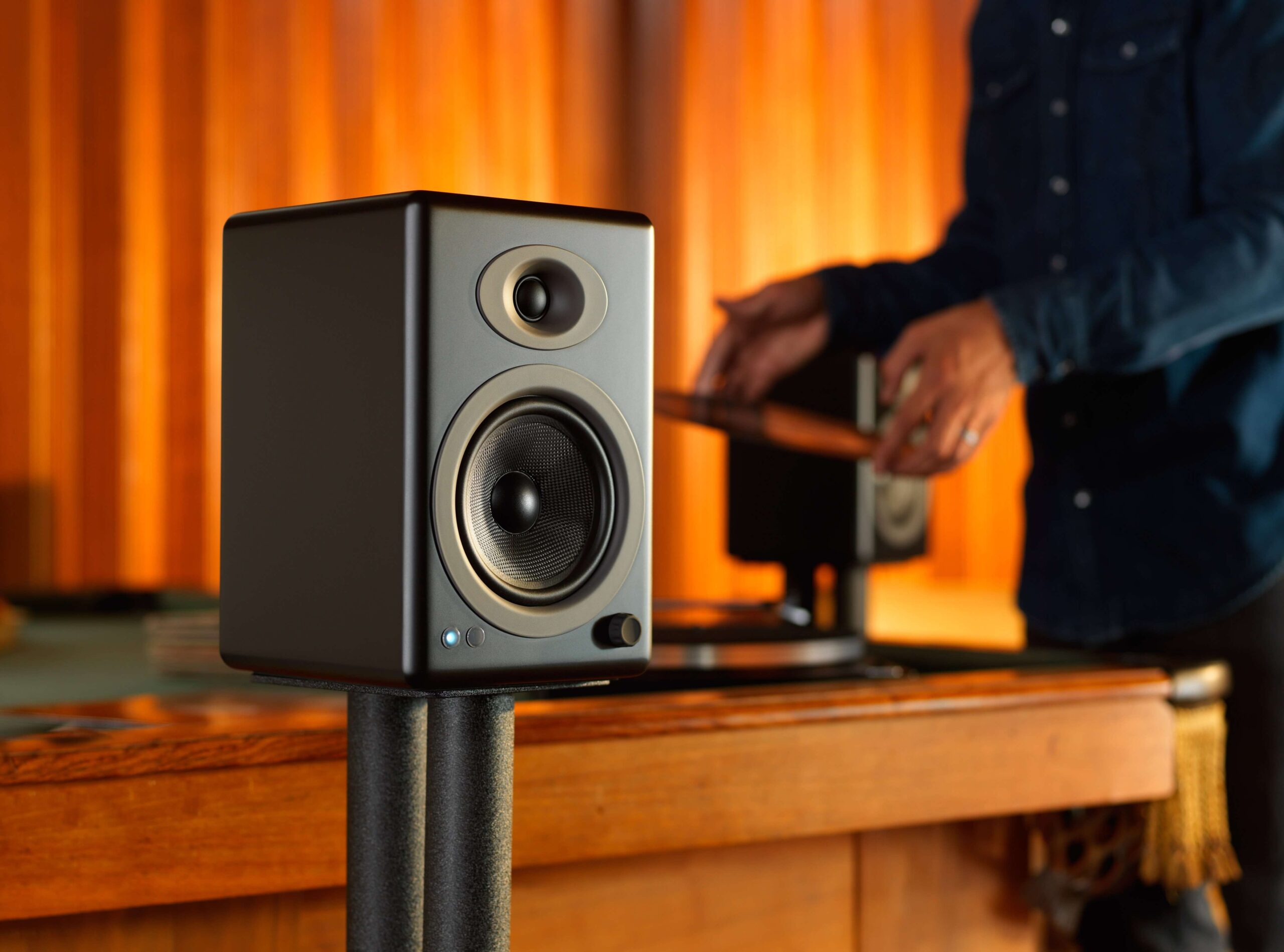
Every Device, Every Platform – All Day, Every Day
Not only does the A5+ work seamlessly with all your apps, music, devices, and music systems, it plays all of your favorite streaming apps, too. TIDAL, Spotify, Pandora, no matter how you listen, A5+ Wireless has you covered.
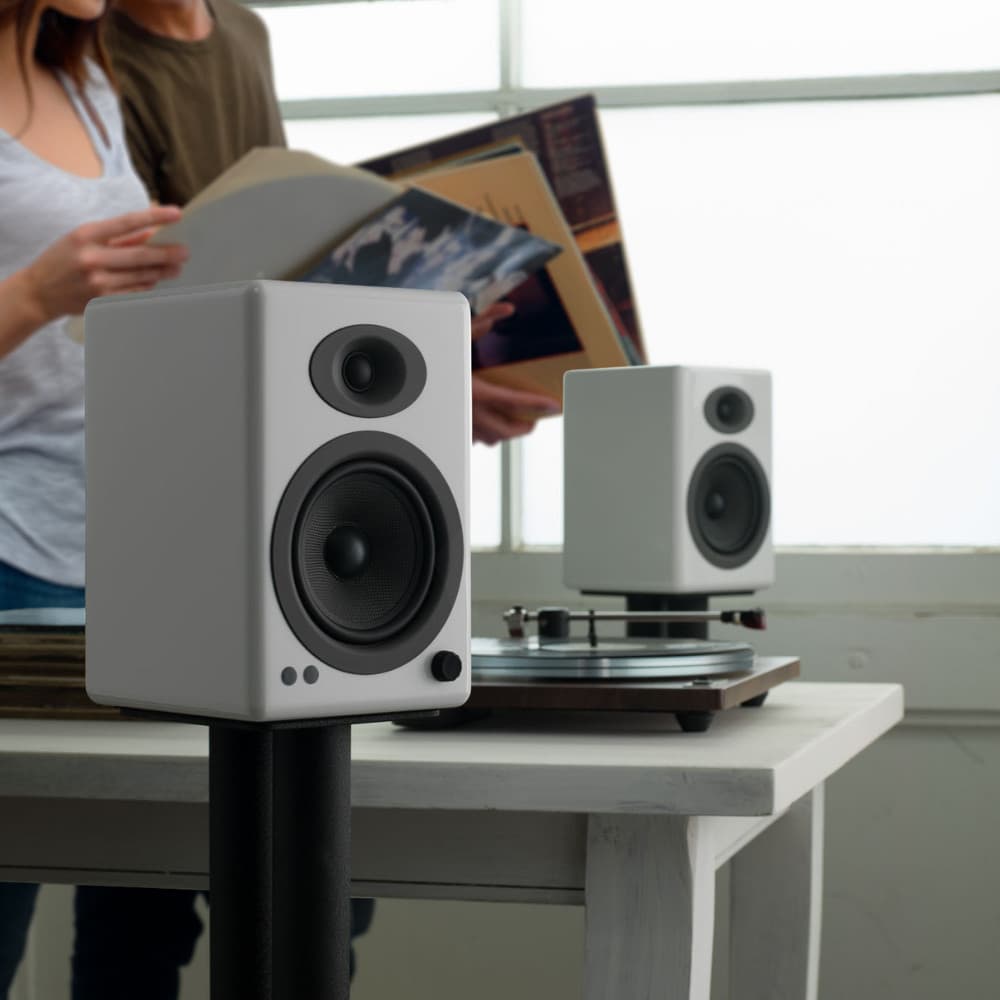
Reasons to love it
- Speakers with a sound to fill any room
- Custom aramid fiber woofers and silk tweeters
- Extended-range wireless aptX-HD Bluetooth, for greater distance and CD-like quality sound
- Comes with remote control
- Built-in power amps wrapped in hand-built wood cabinets, it's the best parts for the most crystal clear sound
- No network setup, no passwords, no hassle, no worries

Spend Less Time on the Setup, More Time on Your Dance Moves
The A5+ Home Music System w/Bluetooth aptX-HD fits on your bookshelf but will fill any sized room. They require no network setup or passwords to enter. In fact, you’ll spend way more time putting your playlist together than setting up the A5+ system.
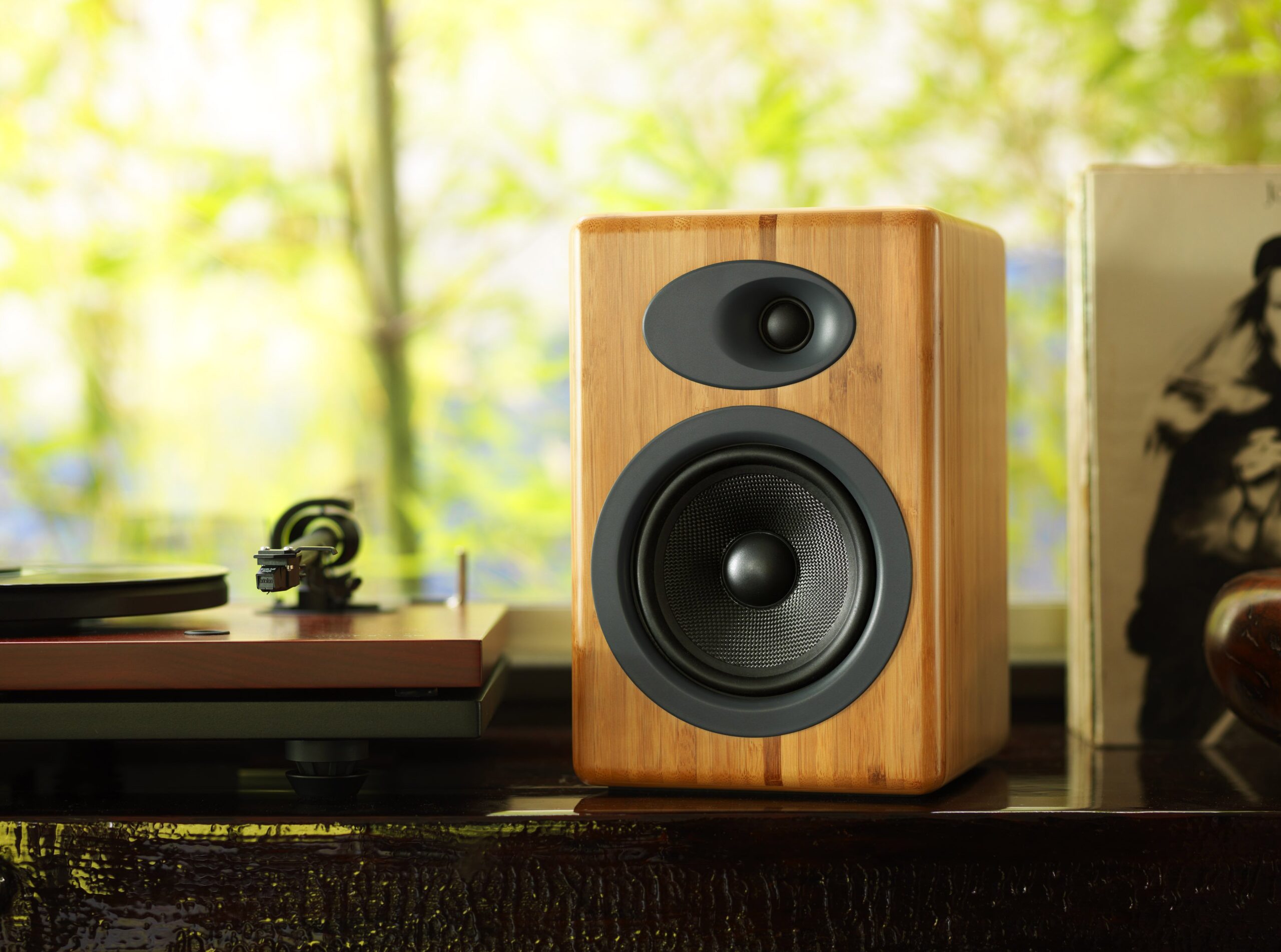
We're Kicking It Old School
Inside the A5+ you'll find traditional analog amplifiers with a sound that's light years ahead of the lower-cost digital amps found in other mass-produced brands. So don't think of our amps as old, think of them as experienced.
What's in the box

Questions & answers about the A5+ Home Music System w/ Bluetooth aptX-HD (Open Box)
1. Turn Off and Unplug:
- Make sure your system is turned off and unplugged.
2. Dust the Surfaces:
- Use a soft, dry cloth to wipe away dust.
- For hard-to-reach places, use a soft brush or a can of compressed air.
3. Wipe Down the Exterior:
- We do not recommend using any solvents
- If cleaning off stains or build-up is necessary, we recommend doing so with a very small amount of mild cleaning solution applied only to the affected area, followed by quickly wiping the area dry completely.
- Any scoured pads or objects like a 'magic eraser' too easily run the risk of removing sealers and top coats of the painted finish that can leave a clearly visible change in the uniformity of the paint/finish
4. Clean the Speaker Grills:
- The speaker grills can be gently cleaned with a vacuum, preferably using a soft bush attachment.
- A lint roller can also be used.
5. Clean Buttons and Knobs:
- A dry cloth is recommend for cleaning any knobs, buttons or other surfaces
- Be careful not to let water get into any gaps.
6. Clean Ports and Connections:
- Use compressed air to blow out dust from ports and connections.
7. Let Everything Dry:
- Make sure everything is completely dry before plugging back in and turning on.
8. Regular Cleaning:
- Dust your system regularly to keep it in good shape.
By following these steps, you can keep your Audioengine system clean and working well.
- The process for replacing a volume encoder begins with pulling the volume knob straight back from the encoder shaft

- Make sure the rubber insert stays with the volume knob -
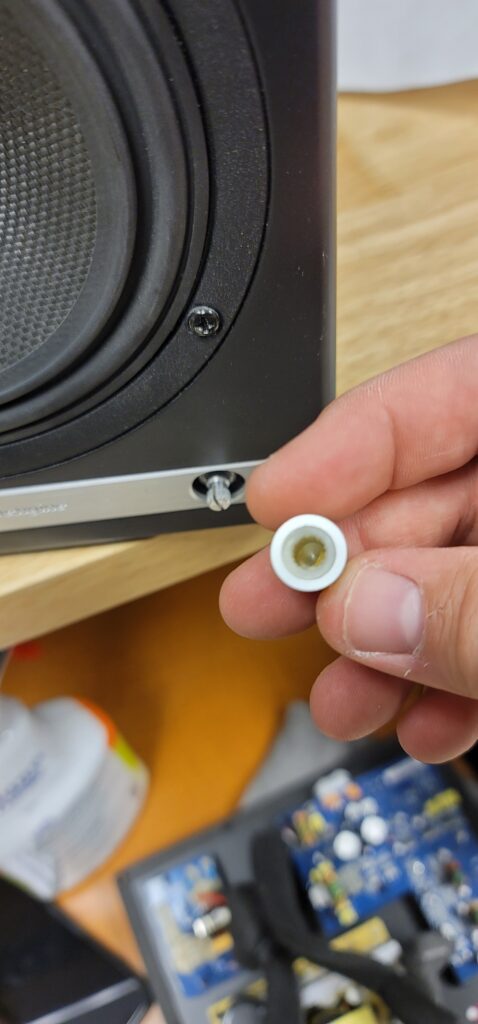
- The volume encoder shaft should look like so before proceeding -
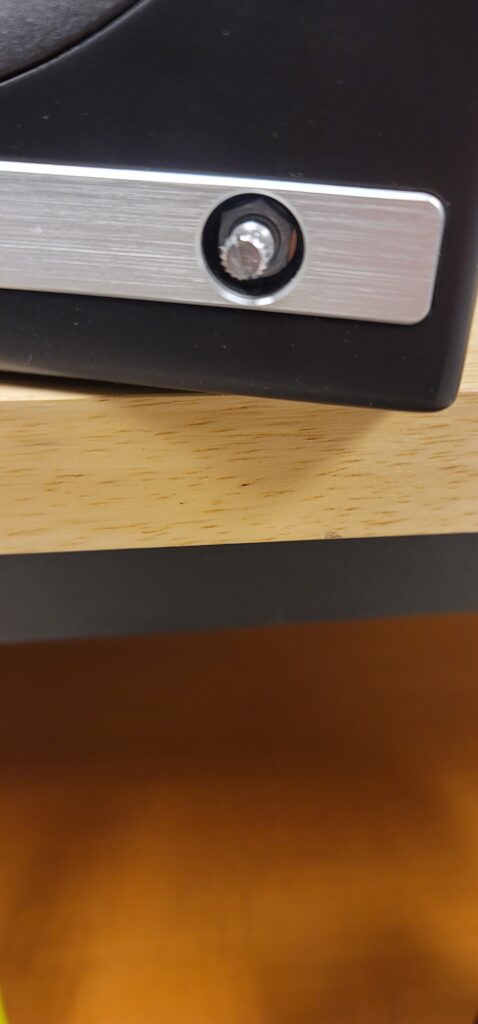
- Using a thin-walled 10mm socket, remove the lock nut fastening the encoder to the front of the speaker cabinet -

- Once you have removed the amp backplate on the back of the active speaker, make sure to remove the encoder wiring terminal clip from the amp circuit board. You can then fully uninstall the encoder assembly by pulling back the encoder shaft from the inside -
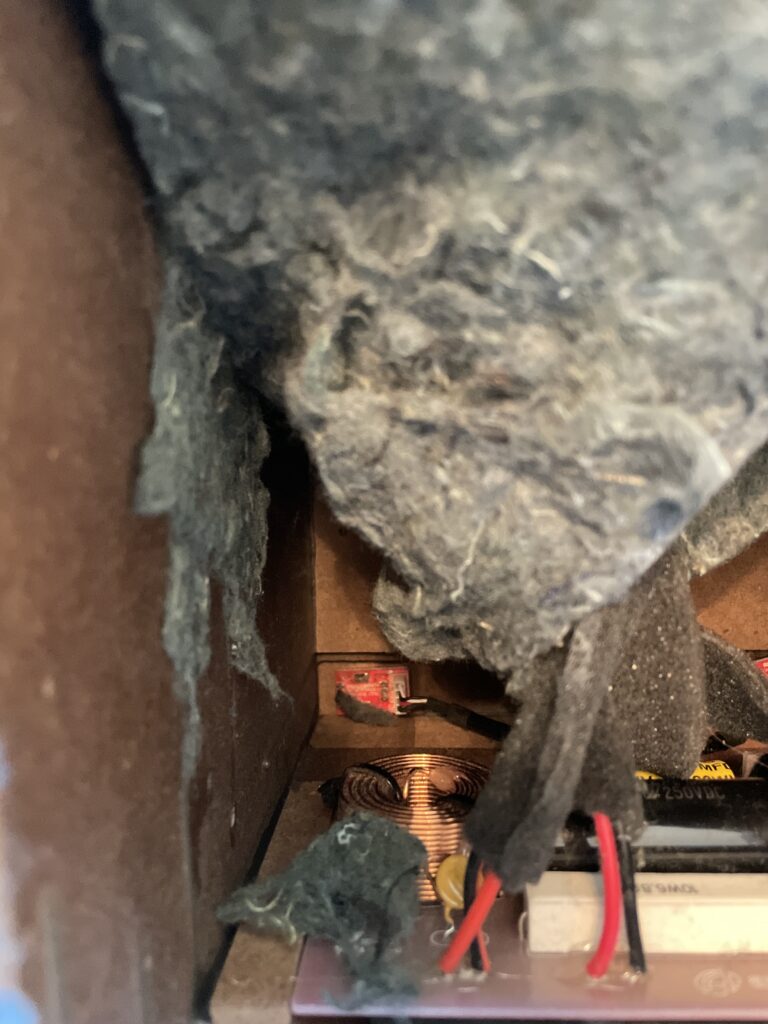
- Finally, the IR receiver can be removed by using a long-necked Phillips PH1 screw driver to remove the 2 screws fastening the IR receiver on the inside of the cabinet -

After fully removing the faulty encoder, the replacement can be installed following these steps in reverse order before finally connecting the wiring clip to the amp circuit board and fastening the amp backplate back onto the active speaker.
The process can be a bit cramped if you wish to do as little disassembly as possible, or a bit easier if you are comfortable moving parts to give yourself more workspace. The sound damping insulation normally overlaps at the bottom of the active cabinet. This can be peeled back similar to the reference picture attached. The crossover is mounted underneath this insulation (If process being done on an HD6) and is perhaps the most obtrusive part when replacing a volume encoder. This has two Philips head screws mounting it to the base of the cabinet along with an adhesive pad to reduce noise vibration. It is possible to remove the two screws and lift the adhered crossover up from the base of the cabinet momentarily to get better access to the IR receiver and volume knob assemblies at the front. If you'd rather not risk damaging anything, the IR receiver can still be unscrewed from the inside of the cabinet with a long-necked Phillips PH1 driver. The volume knob is loosened from the outside of the cabinet with a thin-walled 10mm socket found by pulling the volume knob straight back from the encoder shaft. Ample lighting will also make this work easier
The size of each speaker is 10.75"Hx 7"W x 9"D
Absolutely! You can connect any Audioengine speaker with an analog output to any Sonos product that has the Line-In feature. You can also connect any Audioengine passive speakers into an existing Sonos system using the Sonos Amp.
Absolutely! To do so:
- Open the Alexa App on your smartphone or tablet (Apple link | Google Play Link)
- Tap the “Devices” icon and select the Echo/Alexa device you want to connect to speakers
- Select “Bluetooth Devices”
- Select “Pair New Device”
- Find your Audioengine wireless speaker on the list of available Bluetooth devices, and select it
Yes! We incorporate all the relevant functions and features from Bluetooth 5.0 that apply to our products! These features include; extended range, low latency (so that video and audio sync properly), as well as higher level aptX-HD, aptX, and AAC codecs (with the exception of our 512 portable speaker which supports SBC only). Keep in mind that the capability of the source is what controls the Bluetooth experience.
All turntables require a phono preamp stage before connecting to Audioengine speakers. Many turntables have this built-in , while others do not and would require an external phono preamp. Check the turntable manufacturer’s website or user manual. Some turntables may even include Bluetooth, in which case you can pair and connect them to the speakers wirelessly!
Yep, an AC wall outlet near the A5+ Wireless is all you need to power the W3 or D2 wireless Receiver.
Yes they do! They are equipped with a power-saving circuit that turns off the speaker's final stage amp. This idle mode activates right after you stop playing music. Due to this power-saving function, it's perfectly fine for the speakers to stay on all the time!
Audioengine speakers can be easily connected to your TV set as long as there are analog outputs available. Any of our speakers will provide a greatly enhanced TV audio experience with a wider soundstage and better imaging than most sound bars.
All you would need to do is connect the variable output of the A5+ Wireless into the input of your sub using RCA cables.
Yes. Our A5+ Wireless Speakers feature two analog inputs. Simply connect the Airport Express to one input and the variable output from your TV into the other. Both inputs are "open" or active, so you can leave two audio sources plugged in at the same time with no need to flip any switches.
The A5+ Wireless is not officially supported by any universal remotes. However, you can use a learning remote to copy the signals being sent by the A5+ Wireless's remote. Check with the manufacturer of your remote to find out if it supports learning IR codes.
The short answer is yes! You can use TIDAL on any compatible source device (PC, Mac, iPhone Android, etc.). The A5+ Wireless is compatible with most all of these devices as well since they almost universally also include Bluetooth.
If you have a Mac running Snow Leopard or later, you can create a multiple output device to accomplish this. See the link below for how-to instructions on Apple’s site: https://support.apple.com
Once your A5+ Wireless is paired and connected then any app (iTunes, Amarra, etc.) - or online players such as Youtube - it will automatically play your music through Bluetooth.
It's pretty easy! Our powered speakers are an all-in-one solution with no extra amps or components needed! All you need to do is unpack the speakers, place them where you want, and then plug in the AC cord. Next, connect the powered speaker to the right passive speaker using the included speaker wire. Finally, plug in your music (cell phone, turntable, computer, laptop, etc.) with the supplied cables or via Bluetooth and you're ready to go!
Here is a quick video that can be used as a reference:
(Please note - there is no audio associated with the video.)
The A5+ Wireless uses the same amplifier design and woofers that the A5+ Classic does, so both the A5+ Wireless and the A5+ Classic should sound virtually the same. The biggest difference between the two is the added Bluetooth receiver built into the A5+ Wireless; we’ve added a 24-bit DAC built inside that connects any bluetooth capable device (whether be your phone, tablet, or computer) to the speakers so you can stream high-quality music directly without having to use audio cables. The A5+ Wireless also features a minor cosmetic refresh; the most obvious of which includes centering the tweeters, as opposed to the offset tweeters featured on the A5+ Classic.
No extra software or drivers are needed. The A5+ Wireless is compatible with any device that supports Bluetooth, and the A2DP profile for streaming stereo audio. This includes most smartphones, tablets, and computers.
There is an auxiliary input on the rear panel so you can directly connect any product with an audio output.
You can absolutely still use the A5+ Wireless and it will sound great. AptX is a high-quality Bluetooth audio codec that works really well. In addition to mandatory support for SBC, Bluetooth also includes optional support for many other codecs, like MPEG-1, MPEG-2, MPEG-4, and AAC, all of which have their own advantages, and some of which sound very close to AptX.
Some turntables will need a preamp before being connected and others may have one built-in. With that in mind, it is best to check the turntable manufacturer’s website, the turntable’s user manual, or you can even try your turntable without the preamp first to see how it operates.
Compare Us to the Competition

Fearless
Shopping
- We pay sales tax, if applicable
- 30-day audition & easy returns
- 3-year warranty & superior support
- Guaranteed smiles

We’ve Got Sound Advice for Everyone on Your Gift List
